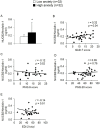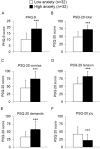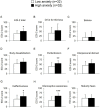NUCB2/nesfatin-1 Is Associated with Elevated Levels of Anxiety in Anorexia Nervosa
- PMID: 26162003
- PMCID: PMC4498697
- DOI: 10.1371/journal.pone.0132058
NUCB2/nesfatin-1 Is Associated with Elevated Levels of Anxiety in Anorexia Nervosa
Abstract
Objective: NUCB2/nesfatin-1 is an anorexigenic hormone with elevated levels in obese and decreased levels in anorexia nervosa (AN) patients. Moreover, a role in the regulation of stress and emotions was suggested by several rodent and preliminary human studies. Since anxiety and depression are common comorbidities in AN, we investigated the association of NUCB2/nesfatin-1 with anxiety, depression and perceived stress in AN.
Methods: We analyzed circulating NUCB2/nesfatin-1 levels in 64 female inpatients diagnosed with anorexia nervosa (body mass index, BMI; mean±SD, 14.7±2.3 kg/m2). At the same time anxiety (GAD-7), depression (PHQ-9), stress (PSQ-20) and disordered eating (EDI-2) were measured psychometrically.
Results: No correlation was observed between NUCB2/nesfatin-1 and BMI (r = 0.06, p = 0.70). The study population was divided in patients with low anxiety (n = 32, GAD-7 scores, mean±SD, 7.5±3.3) and high anxiety (n = 32, 16.0±3.0, p<0.001). Patients with high anxiety scores displayed 65% higher NUCB2/nesfatin-1 levels (p = 0.04). This was reflected by a positive correlation of GAD-7 and NUCB2/nesfatin-1-levels (r = 0.32, p = 0.04). Scores of PSQ-20 (73.3±14.3 vs. 48.6±17.2) and PHQ-9 (18.8±5.0 vs. 10.3±5.1) were higher in the high anxiety group (p<0.001) but did not correlate with NUCB2/nesfatin-1 (p>0.05). EDI-2 total score was also higher in the high anxiety group (52.3±14.1 vs. 40.2±16.0, p = 0.02), while no correlations of EDI-2-scores with plasma NUCB2/nesfatin-1 were observed (p>0.05).
Conclusions: Circulating NUCB2/nesfatin-1 levels correlated positively with perceived anxiety, whereas no association with BMI or eating disorder symptoms was observed. NUCB2/nesfatin-1 might be primarily involved in the modulation of anxiety and subsequently in the regulation of eating habits and body weight in AN.
Conflict of interest statement
Figures



Similar articles
-
NUCB2/nesfatin-1 is associated with elevated scores of anxiety in female obese patients.Psychoneuroendocrinology. 2013 Nov;38(11):2502-10. doi: 10.1016/j.psyneuen.2013.05.013. Epub 2013 Jun 21. Psychoneuroendocrinology. 2013. PMID: 23796625
-
Sex-specific regulation of NUCB2/nesfatin-1: Differential implication in anxiety in obese men and women.Psychoneuroendocrinology. 2015 Oct;60:130-7. doi: 10.1016/j.psyneuen.2015.06.014. Epub 2015 Jun 28. Psychoneuroendocrinology. 2015. PMID: 26143537
-
Alterations of circulating NUCB2/nesfatin-1 during short term therapeutic improvement of anxiety in obese inpatients.Psychoneuroendocrinology. 2017 May;79:107-115. doi: 10.1016/j.psyneuen.2017.02.021. Epub 2017 Feb 21. Psychoneuroendocrinology. 2017. PMID: 28273586
-
The potential role of the novel hypothalamic neuropeptides nesfatin-1, phoenixin, spexin and kisspeptin in the pathogenesis of anxiety and anorexia nervosa.Neurochem Int. 2018 Feb;113:120-136. doi: 10.1016/j.neuint.2017.12.006. Epub 2017 Dec 15. Neurochem Int. 2018. PMID: 29253527 Review.
-
Nesfatin-1; implication in stress and stress-associated anxiety and depression.Curr Pharm Des. 2013;19(39):6941-8. doi: 10.2174/138161281939131127125042. Curr Pharm Des. 2013. PMID: 23537084 Review.
Cited by
-
Nesfatin-1 Hormone Levels in Patients with Antisocial Personality Disorder and Their Relationship with Clinical Variables.Psychiatry Investig. 2020 Sep;17(9):889-895. doi: 10.30773/pi.2020.0067. Epub 2020 Sep 9. Psychiatry Investig. 2020. PMID: 32894929 Free PMC article.
-
SERUM NESFATIN-1 LEVEL IN HEALTHY SUBJECTS WITH WEIGHT-RELATED ABNORMALITIES AND NEWLY DIAGNOSED PATIENTS WITH TYPE 2 DIABETES MELLITUS; A CASE-CONTROL STUDY.Acta Endocrinol (Buchar). 2019 Jan-Mar;-5(1):69-73. doi: 10.4183/aeb.2019.69. Acta Endocrinol (Buchar). 2019. PMID: 31149062 Free PMC article.
-
Nucleobindin-2 consists of two structural components: The Zn2+-sensitive N-terminal half, consisting of nesfatin-1 and -2, and the Ca2+-sensitive C-terminal half, consisting of nesfatin-3.Comput Struct Biotechnol J. 2021 Jul 30;19:4300-4318. doi: 10.1016/j.csbj.2021.07.036. eCollection 2021. Comput Struct Biotechnol J. 2021. PMID: 34429849 Free PMC article.
-
Is there any association between low level of serum nesfatin-1 and fibromyalgia syndrome?Arch Rheumatol. 2020 Jul 1;36(1):38-46. doi: 10.46497/ArchRheumatol.2021.7736. eCollection 2021 Mar. Arch Rheumatol. 2020. PMID: 34046567 Free PMC article.
-
Metabolic Barriers to Weight Gain in Patients With Anorexia Nervosa: A Young Adult Case Report.Front Psychiatry. 2018 May 18;9:199. doi: 10.3389/fpsyt.2018.00199. eCollection 2018. Front Psychiatry. 2018. PMID: 29867616 Free PMC article.
References
-
- Oh-I S, Shimizu H, Satoh T, Okada S, Adachi S, Inoue K, et al. Identification of nesfatin-1 as a satiety molecule in the hypothalamus. Nature. 2006;443(7112):709–712. - PubMed
-
- Brailoiu GC, Dun SL, Brailoiu E, Inan S, Yang J, Chang JK, et al. Nesfatin-1: distribution and interaction with a G protein-coupled receptor in the rat brain. Endocrinology. 2007;148(10):5088–5094. - PubMed
Publication types
MeSH terms
Substances
LinkOut - more resources
Full Text Sources
Other Literature Sources
Medical

